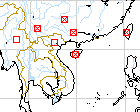Illustration from Kurz (1873).

Distribution (Missouri Botanical Garden TROPICOS database 2006).
Calocedrus macrolepis
Bách xanh, Tùng hương, Pơ mu giả, Trắc bách diệp núi [Vietnamese], cui bai [Chinese] (Hiep et al. 2004).
Syn: Libocedrus macrolepis (Kurz.) Benth. (Silba 1986).
Evergreen tree 15-25 (rarely 30) m tall with dbh to 60-80 cm. Bole straight, often twisted when over 10 m high. Bark dark brown with longitudinal fissures. Early branched, with big branches nearly horizontal; crown oviform. Leaves scaly, closely inserted on twigs into nodes, each node with two large leaves and two smaller opposite leaves. Female cone oval, very small, green when young, becoming violet-brown, lignified and opening into 3 fragments when mature with the middle fragment bearing 2 big winged seeds, which mature in October-December (FIPI 1996).
NE Myanmar, China: Guangxi, Guizhou, Hainan, Taiwan, & Yunnan at 300-2000m elevation; Vietnam. In Vietnam, found in Khanh Hoa, around Da Lat city in Lam Dong, and at Ba Vi mountain in Ha Tay. It prefers a humid climate and yellow ferallitic soils with shallow or moderately thick, but humus-rich surface layers. It grows at elevations above 900 m in closed and open evergreen subtropical forests, in mountainous areas. Regeneration is good in places with ample light, such as along streams or at forest edges (FIPI 1996). Hardy to Zone 9 (cold hardiness limit between -6.6°C and -1.1°C) (Bannister and Neuner 2001).
Listed as threatened/endangered in Vietnam. Due to small population size and extensive habitat loss, this species needs strict protection in Ba Vi National Park and in Bidoup Nature Reserve (WCMC 2001).
Some trees in the Xishuangbanna area of Yunnan are 35-40 m tall (Vladimir Dinets e-mail 1998.01.10).
Wood not strong, but straight-grained and with a moderately fine texture, easily worked. Resistant to termites and insects. Used as construction timber, for cabinet-work and for woodturning. The wood is aromatic, and can be used in joss-stick making. As the tree has a beautiful crown and form, it is also planted for decorative purpose (FIPI 1996).
Probably most easily seen in Ba Vi National Park and in Bidoup Nature Reserve, Vietnam. It could likely be found in some of the nature preserves of Yunnan, as well.
Kurz, S. 1873. On a few new plants from Yunan. Journal of Botany 11:193-196, t. 133. Available: Biodiversity Heritage Library, accessed 2012.11.25.
Missouri Botanical Garden TROPICOS database. Queried 2006.07.12. http://www.mobot.org/MOBOT/TROPICOS/China/China2/N09400426.html, now defunct.
[WCMC] World Conservation Monitoring Centre. The Socialist Republic of Viet Nam Appendix 5 - Threatened Plant Species. http://www.wcmc.org.uk/infoserv/countryp/vietnam/app5.html, accessed 2001.11.25, now defunct.
Elwes and Henry 1906-1913 at the Biodiversity Heritage Library (as Libocedrus macrolepis). This series of volumes, privately printed, provides some of the most engaging descriptions of conifers ever published. Although they only treat species cultivated in the U.K. and Ireland, and the taxonomy is a bit dated, still these accounts are thorough, treating such topics as species description, range, varieties, exceptionally old or tall specimens, remarkable trees, and cultivation. Despite being over a century old, they are generally accurate, and are illustrated with some remarkable photographs and lithographs.
Farjon (2005) provides a detailed account, with illustrations.
Huang 1994 (the Flora of Taiwan).
Luu and Thomas 2004 provide a description, range map, conservation status, drawings and photos, and a wealth of additional information.
Last Modified 2023-03-03